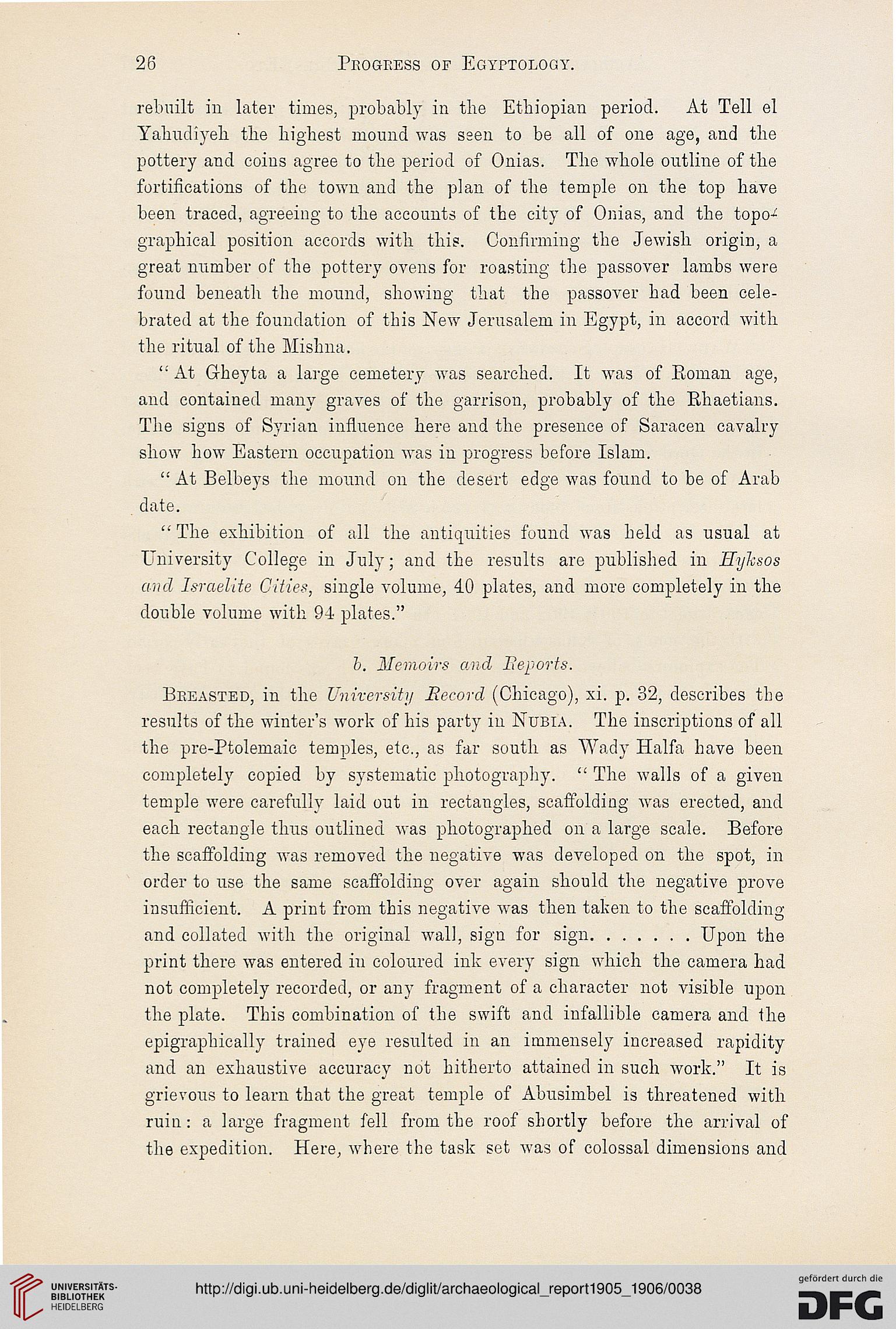26
Progress of Egyptology.
rebuilt in later times, probably in the Ethiopian period. At Tell el
Yahudiyeh the highest mound was seen to be all of one age, and the
pottery and coins agree to the period of Onias. The whole outline of the
fortifications of the town and the plan of the temple on the top have
been traced, agreeing to the accounts of the city of Onias, and the topo-
graphical position accords with this. Confirming the Jewish origin, a
great number of the pottery ovens for roasting the passover lambs were
found beneath the mound, showing that the passover had been cele-
brated at the foundation of this New Jerusalem in Egypt, in accord with
the ritual of the Mishna.
<: At Gkeyta a large cemetery was searched. It was of Roman age,
and contained many graves of the garrison, probably of the Rhaetians.
The signs of Syrian influence here and the presence of Saracen cavalry
show how Eastern occupation was in progress before Islam.
" At Belbeys the mound on the desert edge was found to be of Arab
date.
" The exhibition of all the antiquities found was held as usual at
University College in July; and the results are published in Hyksos
and Israelite Cities, single volume, 40 plates, and more completely in the
double volume with 94 plates."
b. Memoirs and Reports.
Beeasted, in the University Eecord (Chicago), xi. p. 32, describes the
results of the winter's work of his party in Nubia. The inscriptions of all
the pre-Ptolemaic temples, etc., as far south as Wady Haifa have been
completely copied by systematic photography. " The walls of a given
temple were carefully laid out in rectangles, scaffolding was erected, and
each rectangle thus outlined was photographed on a large scale. Before
the scaffolding was removed the negative was developed on the spot, in
order to use the same scaffolding over again should the negative prove
insufficient. A print from this negative was then taken to the scaffolding
and collated with the original wall, sign for sign.......Upon the
print there was entered in coloured ink every sign which the camera had
not completely recorded, or any fragment of a character not visible upon
the plate. This combination of the swift and infallible camera and the
epigraphically trained eye resulted in an immensely increased rapidity
and an exhaustive accuracy not hitherto attained in such work." It is
grievous to learn that the great temple of Abusimbel is threatened with
ruin: a large fragment fell from the roof shortly before the arrival of
the expedition. Here, where the task set was of colossal dimensions and
Progress of Egyptology.
rebuilt in later times, probably in the Ethiopian period. At Tell el
Yahudiyeh the highest mound was seen to be all of one age, and the
pottery and coins agree to the period of Onias. The whole outline of the
fortifications of the town and the plan of the temple on the top have
been traced, agreeing to the accounts of the city of Onias, and the topo-
graphical position accords with this. Confirming the Jewish origin, a
great number of the pottery ovens for roasting the passover lambs were
found beneath the mound, showing that the passover had been cele-
brated at the foundation of this New Jerusalem in Egypt, in accord with
the ritual of the Mishna.
<: At Gkeyta a large cemetery was searched. It was of Roman age,
and contained many graves of the garrison, probably of the Rhaetians.
The signs of Syrian influence here and the presence of Saracen cavalry
show how Eastern occupation was in progress before Islam.
" At Belbeys the mound on the desert edge was found to be of Arab
date.
" The exhibition of all the antiquities found was held as usual at
University College in July; and the results are published in Hyksos
and Israelite Cities, single volume, 40 plates, and more completely in the
double volume with 94 plates."
b. Memoirs and Reports.
Beeasted, in the University Eecord (Chicago), xi. p. 32, describes the
results of the winter's work of his party in Nubia. The inscriptions of all
the pre-Ptolemaic temples, etc., as far south as Wady Haifa have been
completely copied by systematic photography. " The walls of a given
temple were carefully laid out in rectangles, scaffolding was erected, and
each rectangle thus outlined was photographed on a large scale. Before
the scaffolding was removed the negative was developed on the spot, in
order to use the same scaffolding over again should the negative prove
insufficient. A print from this negative was then taken to the scaffolding
and collated with the original wall, sign for sign.......Upon the
print there was entered in coloured ink every sign which the camera had
not completely recorded, or any fragment of a character not visible upon
the plate. This combination of the swift and infallible camera and the
epigraphically trained eye resulted in an immensely increased rapidity
and an exhaustive accuracy not hitherto attained in such work." It is
grievous to learn that the great temple of Abusimbel is threatened with
ruin: a large fragment fell from the roof shortly before the arrival of
the expedition. Here, where the task set was of colossal dimensions and





